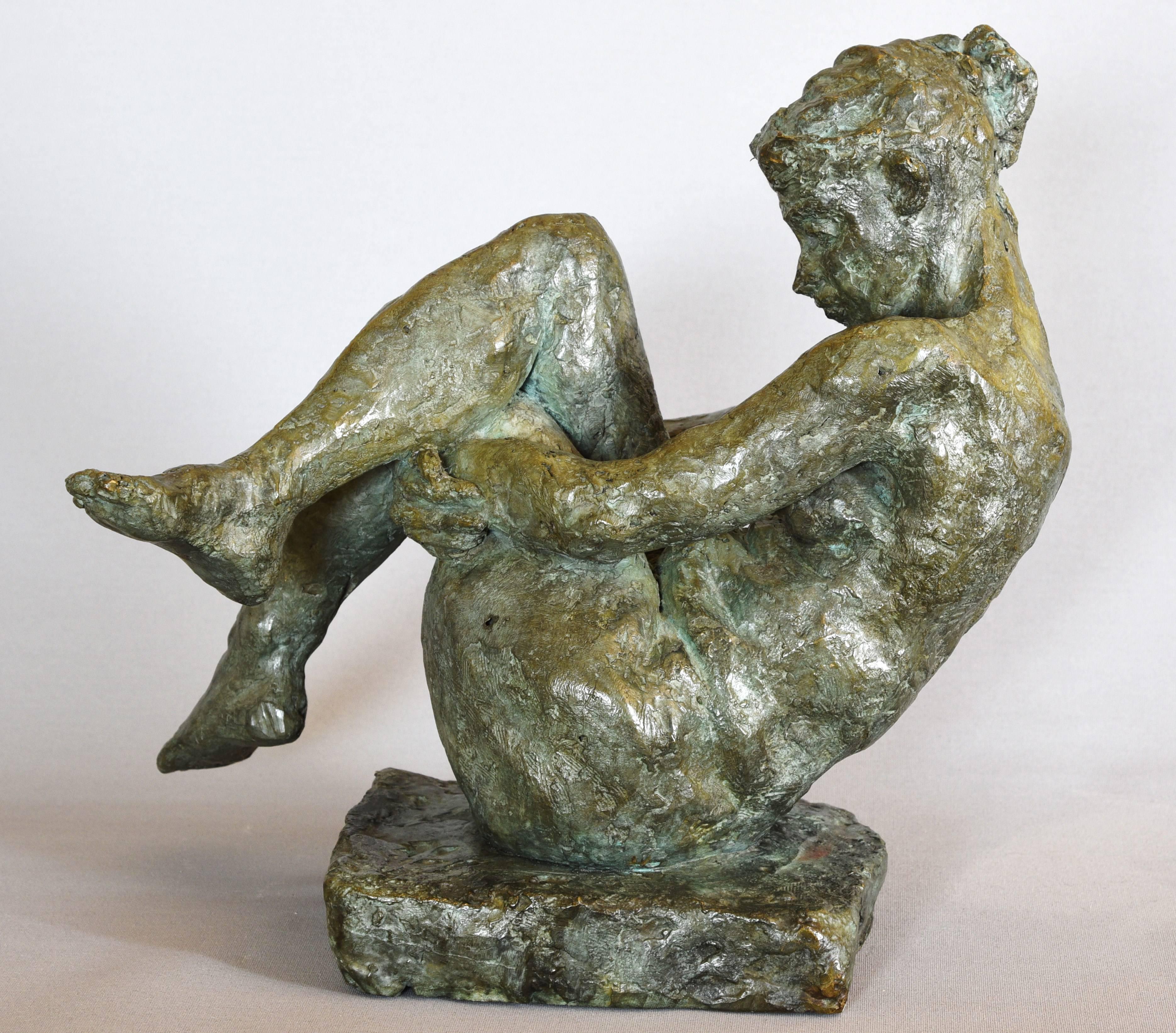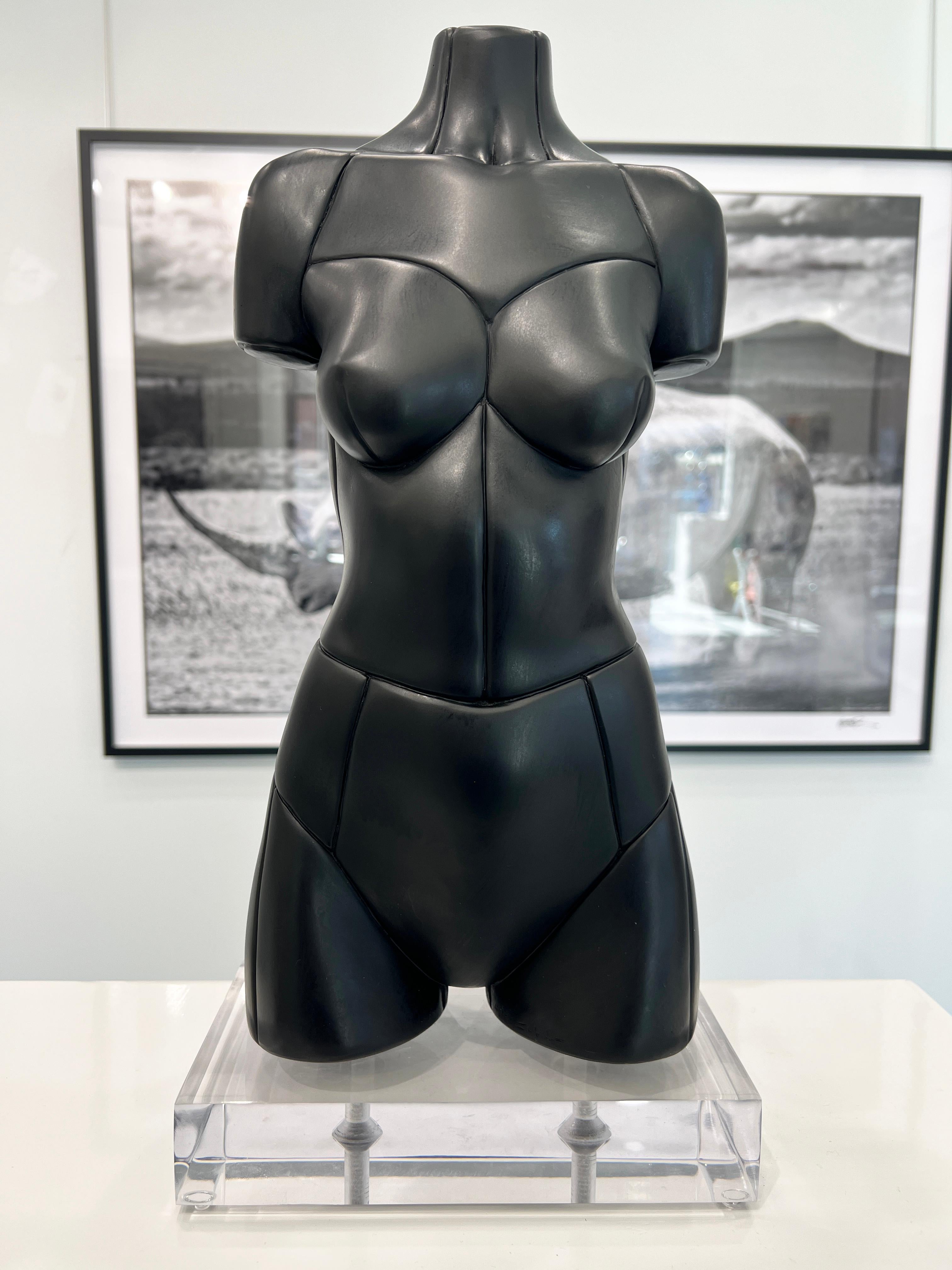Items Similar to L'Enfer des Luxurieux, The Hell of the Luxurious Relief, 19th Century Bronze.
Want more images or videos?
Request additional images or videos from the seller
1 of 11
Jean-François Garnier L'Enfer des Luxurieux, The Hell of the Luxurious Relief, 19th Century Bronze.c.1859-1864
c.1859-1864
About the Item
A rare round relief cast, elaborate chiseled bronze/copper with brown patina by Jean François Marie Garnier (1820-1895). Cast c.1859-1864. Not signed. The motif is taken from Dantes, The Divine Comedy´s, first part, Inferno and the second circle, called "L'Enfer des Luxurieux", in english "The Hell of the Luxurious". See identical relief, signed Jean Garnier, in Musée d'Orsay in Paris, inventory no. OA 3666, also belonging to the Louvre collections. Another cast of the relief is part of the Museum of Lyon collections. Framed in a 19th century stained oak frame. The dimensions are the exact as the one in Musée d'Orsay. Later copies, of which a few are known, usually have a larger diameter and lesser quality in casting etc.
The relief, L'Enfer des Luxurieux, in the Musée d'Orsay collection, was exhibited 2023-2024 during the exhibition: Louis Janmot, "The Poem of the Soul", in french 'Le Poème de l’âme'.
From the introduction text of the exhibition:
"The Poem of the Soul" suit was begun in Rome in 1835 and completed in 1881, The Poem of the Soul is the crowning achievement of the Lyonese artist Louis Janmot (1814-1892), a pictorial and literary work all in one. In 34 compositions accompanied by a long poem, it illustrates a soul’s initiatory journey on Earth.
Garnier and Janmot were both from Lyon and they probably knew each other and Garnier was likely inspired by Janmot´s work. Jean Francois Marie Garnier was born in Lyon and died in Paris. He is sometimes mixed up with another artist, with a very similar name, Alfred Jean Garnier (1848-1921).
During the 19th century, particularly with romanticism, then symbolism, the representation of the soul took on considerable importance. Artists respond in varied ways to the same iconographic problem: how to represent an immaterial entity, distinct from the body and having an existence beyond death? In turn, the soul takes the form of a winged female figure, an allegory of purity and spirituality, or materializes in the form of a shadow or a flow escaping from the body.
The second circle, in Dantes Inferno, depicted in this relief shows the fate of the damned souls, also called the “lustful”. The souls in this circle is to be swept away by relentless winds. All people guilty of the sin of lust are whirled round and round in an unending storm. The storm, represents irresistible passion. Among those being blown about are mythic and historical queens. The sin of these souls is that of having submitted reason to their carnal appetites, of having committed the sin of the flesh. Among them are the souls of Semiramis, Cleopatra, Dido, Helen of Troy, Paris, Tristan, Francesca da Rimini and Paolo Malatesta.
The two center figures embracing each other in the relief depicts Francesca da Rimini and Paolo Malatesta.
The Divine Comedy is a literary masterpiece written by Dante Alighieri (1265-1321) in the first half of the 14th century. The Comedy symbolises humankind’s journey for redemption through the three afterlife kingdoms: Inferno, Purgatory and Paradise.
While Purgatory and Paradise are embedded with theological and philosophical considerations, Inferno is a testimony of the political corruption at that time. Italy was the battlefield for the political fights between the Pope and the Emperor. It was one of the most merciless ‘Games of Thrones’ in medieval history.
Dante tells the story of many political and religious figures, who – blinded by political ambitious – committed murders, cannibalism, treason, and suicide all in the name of ‘worldly power’.
In a sense, Dante’s Inferno is the first attempt to challenge the dominant social imaginary through storytelling. Dante is aware that unless humanity achieves spiritual redemption, his world will be forever lost in the wood of sins and corruption.
Each circle that constitutes Hell introduces characters that embed a specific characteristic of the dominant imaginary that needs to be criticized. The only exception can be found in Canto V (chapter V), in which – only on this occasion- Dante took pity of two condemns: Paolo and Francesca di Rimini.
Canto V is the testimony of Dante’s powerful narrative technique that triggers empathy in the readers. Even though Paolo and Francesca committed adultery and therefore had to be put in the circle of the lustful, their love story is so moving that the readers conceive them as the innocent victims of a dreadful/unjust fate.
Francesca di Rimini was a beautiful noble girl – destined to become a nun – but she was kidnapped and forced to marry the violent Gianciotto Malatesta, Paolo’s older brother. While living together, Paolo and Francesca fell in love. Unfortunately, the brother discovered their affair and killed the two lovers, condemning his brother and his wife to an eternity in Hell. Nevertheless, Paolo and Francesca’ sin becomes secondary to the readers because what really matters is that their life was brutally interrupted. Paolo and Francesca can be finally together and free to live their love but they have to go through eternal suffering.
In this Canto, Dante uncommonly employs a sweet, romantic and poetic language. The words are characterized by a slow rhythm that creates emphasis and pathos to the story. The readers are capable of creating an emotional connection with the characters and cannot help identifying themselves with the pain and sorrow these two star-crossed lovers have to go through every day to be together.
Paolo and Francesca’s story is an outstanding example of the emotional power of language that may open doors to change and better justice.
- Creator:Jean-François Garnier (1820 - 1895, French)
- Creation Year:c.1859-1864
- Dimensions:Height: 1.19 in (3 cm)Diameter: 20.87 in (53 cm)
- Medium:
- Movement & Style:Symbolist
- Period:
- Condition:There are a few breakage places on the outer rim of the cast, one barely visible by the frame edge.
- Gallery Location:Stockholm, SE
- Reference Number:1stDibs: LU2608213929842
About the Seller
5.0
Gold Seller
These expertly vetted sellers are highly rated and consistently exceed customer expectations.
1stDibs seller since 2023
6 sales on 1stDibs
Typical response time: 1 hour
- ShippingRetrieving quote...Ships From: Stockholm, Sweden
- Return PolicyA return for this item may be initiated within 14 days of delivery.
More From This SellerView All
- Elephant Sculpture, Bronze, Mother and Baby Elephant 19th Century, Marble Base.Located in Stockholm, SEA fine patinated bronze sculpture of a mother elephant with her baby elephant by Niels Holm (1860-1933). Signed NIELS HOLM, ELEPHASINDICUS, ENDANGER. Also signed L. RASMUSSEN, KOBENH...Category
Late 19th Century Naturalistic Figurative Sculptures
MaterialsMarble, Bronze
- 16th Century Cameo Pendant of Christ the Redeemer in a Gilt Bronze FrameLocated in Stockholm, SEA finely carved 16th or early 17th century large hard stone pendant cameo of Christ the Redeemer in profile. Set in period a gilt bronze frame. Possibly Italian. The profile view of...Category
16th Century Italian School Figurative Sculptures
MaterialsPrecious Stone
- Oriental Sunset Landscape By The Sea, Oil on Cardboard. 19th century.Located in Stockholm, SEA fine painting depicting an oriental shoreline sunset with red skies and two oriental women walking towards their village by the beach and sea. Oil on cardboard by an unidentified a...Category
Late 19th Century Naturalistic Landscape Paintings
MaterialsOil, Cardboard
- Oriental Man Wearing a Fez, Oil on Canvas, 19th Century.Located in Stockholm, SEA fine portrait of an oriental bearded man, wearing a fez and holding a walking stick, second half of the 19th century. Oil on canvas. Relined. Unknown artist but probably Swedish. ...Category
Late 19th Century Other Art Style Figurative Paintings
MaterialsCanvas, Oil
- South Funen Archipelago, People Fishing Next to The Shore. Oil on canvas, 1861.Located in Stockholm, SEA fine oil painting by Emil Cordius Heinrich Orth (1833-1919) depicting a woman and a man in a rowing boat near the shore laying out fishing nets on a sunny summer day. It is signed ...Category
1860s Naturalistic Landscape Paintings
MaterialsOil, Canvas
- 19th Century Still-Life, A Lantern, Tankard, Wine Ewer, Apple and Fork.Located in Stockholm, SEA charming 19th century still-life, oil on canvas depicting an 18th century wine ewer, lantern, stoneware tankard with a blue ribbon bow, fork with a sculptured ivory handle, and an ...Category
19th Century Still-life Paintings
MaterialsCanvas, Oil
You May Also Like
- Lying Body by Sergio Monari 1985 Figurative Sculpture Patinated Bronze CastBy Sergio MonariLocated in Brescia, ITBronze artwork made with lost wax casting technique. This is the prototype, unique signed artist proof. Sergio Monari is an Italian sculpture, that liv...Category
1980s Post-Minimalist Figurative Sculptures
MaterialsBronze
- 1985 Figurative Sculpture Patinated Bronze Cast Sergio MonariBy Sergio MonariLocated in Brescia, ITBronze artwork made with lost wax casting technique. This is the prototype, unique signed artist proof. Title "Sleeping body" Sergio Monari is an Italia...Category
1980s Post-Minimalist Figurative Sculptures
MaterialsBronze
- Crouched Body by Sergio Monari 1985 Figurative Sculpture Patinated Bronze CastBy Sergio MonariLocated in Brescia, ITBronze artwork made with lost wax casting technique. This is the prototype, unique signed artist proof. Sergio Monari is an Italian sculpture, that lives and works in Bologna, Italy. He exhibited his artworks in the best Galleries...Category
1980s Post-Minimalist Figurative Sculptures
MaterialsBronze
- nudeBy YbahLocated in Pasadena, CAAfter studying fine arts, a need for contact with solid material was needed. Ybah took a classic artistic path from an academic education from the Louvre reproductions, learning at t...Category
20th Century Nude Sculptures
MaterialsBronze
- Upholstered TorsoBy Christopher SchulzLocated in Miami, FLChristopher Schulz's "stitched together" female figure mimics the effect of delicate upholstery through the medium of bronze. Set on an acrylic base. Christopher Schulz was born in ...Category
2010s Figurative Sculptures
MaterialsBronze
- Fotografo II, bronze and stainless figurative sculptureBy Aurora CaneroLocated in Miami, FLSculpture, bronze and stainless, figurative Edition of 6 Measurement includes stainless base and bronze sculptureCategory
Early 2000s Contemporary Figurative Sculptures
MaterialsBronze
Recently Viewed
View AllMore Ways To Browse
Round Relief
Antique Relief Sculpture
Wood Relief Sculpture
Relief Doors
Bronze Nude Figure
Antique Bronze Nude
Antique Nude Bronze
Bronze Relief Large
Brutal Sculptures
The Lovers Bronze
Relief Nude
How To Submit
Wood Relief Door
Antique Emperor Sculpture
The Embrace Bronze Sculpture
Nude Female Sculptures Large
Erotic Bronze
Large Wing Sculpture

